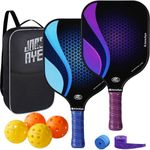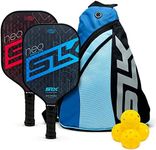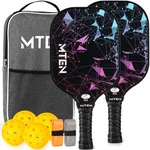Buying Guide for the Best Pickleball Paddle For Beginners
Choosing your first pickleball paddle can feel overwhelming, but it’s all about finding a paddle that matches your comfort, playing style, and physical needs. As a beginner, you want a paddle that helps you learn the game, develop your skills, and enjoy playing. Focus on paddles that are easy to handle, forgiving, and not too specialized. Understanding the key features will help you make a confident choice.WeightWeight is one of the most important factors in a pickleball paddle. It affects how easy the paddle is to swing, how much power you can generate, and how much control you have. Lighter paddles (around 6.5-7.2 ounces) are easier to maneuver and are good for players who value control and have less arm strength. Medium-weight paddles (7.3-8.4 ounces) offer a balance between power and control, making them a great choice for most beginners. Heavier paddles (8.5 ounces and above) provide more power but can be tiring to use and harder to control, especially for new players. As a beginner, a medium-weight paddle is usually the best starting point, as it helps you learn both control and power without straining your arm.
Grip SizeGrip size refers to the circumference of the handle and is important for comfort and injury prevention. A grip that’s too large or too small can make it hard to control the paddle and may cause hand or wrist discomfort. Smaller grips (around 4 inches) are better for players with smaller hands and allow for more wrist action, which can help with control. Larger grips (4.5 inches and above) are suited for bigger hands and can provide more stability. To find the right grip size, try holding a few paddles and see which feels most comfortable and secure in your hand. If you’re unsure, it’s safer to go slightly smaller, as you can always add an overgrip to increase the size.
Paddle Face MaterialThe face material of a paddle affects its feel, durability, and performance. Common materials include composite, graphite, and wood. Wood paddles are the most affordable and durable but are heavy and less responsive, making them less ideal for beginners. Composite paddles offer a good balance of power and control and are lightweight, making them a popular choice for new players. Graphite paddles are also lightweight and provide excellent touch and control, but can be more expensive. For beginners, composite or graphite paddles are usually best, as they are easier to handle and help you develop your skills.
Paddle Shape and SizePaddles come in different shapes and sizes, which affect the size of the hitting area (sweet spot) and how the paddle feels in play. Standard paddles have a balanced shape and a large sweet spot, making them forgiving and easy to use for beginners. Elongated paddles offer more reach and power but have a smaller sweet spot and can be harder to control. Widebody paddles have an even larger sweet spot and are very forgiving, which is great for new players. As a beginner, look for a standard or widebody paddle to help you make consistent contact with the ball and build confidence.
Core MaterialThe core of the paddle is usually made from polymer, aluminum, or Nomex. Polymer cores are the most common and provide a good mix of power, control, and quiet play, making them ideal for beginners. Aluminum cores are lighter and offer more control but less power, while Nomex cores are harder and provide more power but can be noisy and less forgiving. For most beginners, a polymer core is the best choice because it offers a comfortable feel and helps you learn the basics without being too harsh on your arm.



















